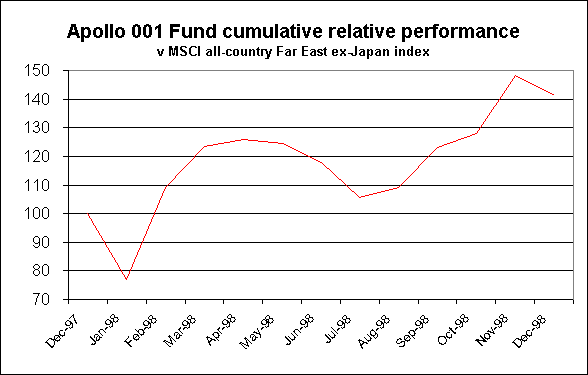
The fund
At present, over 80% of the portfolio is invested in Hong Kong, Singaporean and Malaysian equities, with smaller exposures in Thailand and Kazakstan.
Recent company visits have ranged from Korea through the Philippines to Indonesia. It is possible that the geographical allocation will change dramatically in future, but this is not immediately envisaged. At present I believe China best played through selected Hong Kong companies.
89% of the fund is invested in equities. 2% is in warrants: this exposure times the warrants’ gearing would increase the exposure to their underlying equities to 9%. High-yielding bonds account for 8% of the portfolio, and a deeply-discounted closed-end fund for 1% - the small size of the latter stake is because we have been unable to obtain more.
These allocations were reached as the aggregate of bottom-up decisions on individual securities. Investors whose philosophy is similar to the manager’s will find the next section the most interesting.

Valuation, and examples of our holdings
Written for the Apollo 001
Fund on 30 December 1998
For the portfolio overall, the current year PE is 6.3. We often prefer to invert this and think of the earnings yield, which is 16%. The current year after-tax dividend yield is estimated at 6.1%, and price to historic book is 79%.
The earnings and dividend figures are our own estimates for the current year, which in many cases should mark the nadir; it has certainly been quite a tough year for Asian companies! (Most financial years end in December or March; a minority run to June.)
We do not hesitate to buy shares which dilute these aggregate portfolio numbers, if we believe they have intrinsic value and will therefore in the long run generate absolute returns. Rigid valuation-based approaches (low PE, or whatever) can be as dangerous as the reverse (chasing growth without adequate regard to value).
Company examples
The best-known department store chain in Singapore is currently selling below cash. Its balance sheet strength is legendary, and the returns on the actual operating assets extraordinary. As you may imagine, the combination is staid. Corporate attitudes to shareholder value are changing dramatically in parts of Singapore; early hopes of change for this particular company have been dampened, but the downside seems limited while we wait.
We own several Malaysian plantations, which were bought on sustainable PE’s of 5-6 and are now on 7-8. This may sound unexciting but these are US dollar earners, relatively steady and reliable, and inverting the figures this still gives us earnings yields of 12-15%. Net dividend payouts are a respectable portion of this, and 60% of our plantation holdings have major volume growth coming through from young acreage.
We own shares in two of the best brokerage firms in the region. We have no great expectations about their short-term earnings, so they dilute our attractive valuation averages. They are tightly run and we do not expect them to lose money during the downturn, but they will go into an upturn with enormous operating leverage – the more so for the demise of many competitors with lesser balance sheets. We bought both at substantial discounts to cash. They are not quite so cheap now, but are both close to net tangible asset value, with very little premium for the franchise, so we are certainly not selling.
We have a small stake in one country fund, valued at a 50% discount to NAV (a 62% discount adjusted for cash); it is expected to become open-ended and liquidate at the end of 1999.
One Hong Kong company in which we increased our stake quite aggressively in the last fortnight was valued at 1.3 times free cash flow. The price was also less than half of book, on a PE of about 4, and a dividend yield of 12%. Management is excellent, competitors are falling all around, and business may already be picking up.
Another recent purchase in Hong Kong was on a dividend yield of 17%, with the market price capitalising the whole company at net current assets. Cash represents 80% of the net current assets, and the balance is mainly receivables from blue-chip US names.
This month we finally sold the last tranche of our most successful share of the year, at five times the entry price. (This was an ordinary stock, not a warrant.) The beauty of this one was that it was very low risk at the time of purchase; net assets were of the order of twelve times the share price, although under-worked, and the newly established dividend policy put it on a dividend yield of 20% which the ultra-conservative directors clearly considered sustainable.
Overall, the Hong Kong portion of the portfolio is on a PE of 5, yielding over 10%, and at less than two-thirds of book. The yields are cash dividend yields (and there is no double taxation of dividends in our core markets); several of the companies are also buying back and cancelling shares. All of our major holdings are successfully operating some part of their business in China, and building up valuable experience there. All are long term growth stocks.
Forgive the lack of names here (although many may be identifiable), as this document may be given broad circulation: I have been intellectually mugged several times in the last few years by professional investors, even those introduced by friends, and have tired of the experience. More importantly, some of these shares are illiquid and we may wish to buy more. Nevertheless, I love discussing investment pros and cons with those of like mind and appropriate spirit; if you would like more details, please get in touch.
|
|
|
|
|
|
|
|
|
|